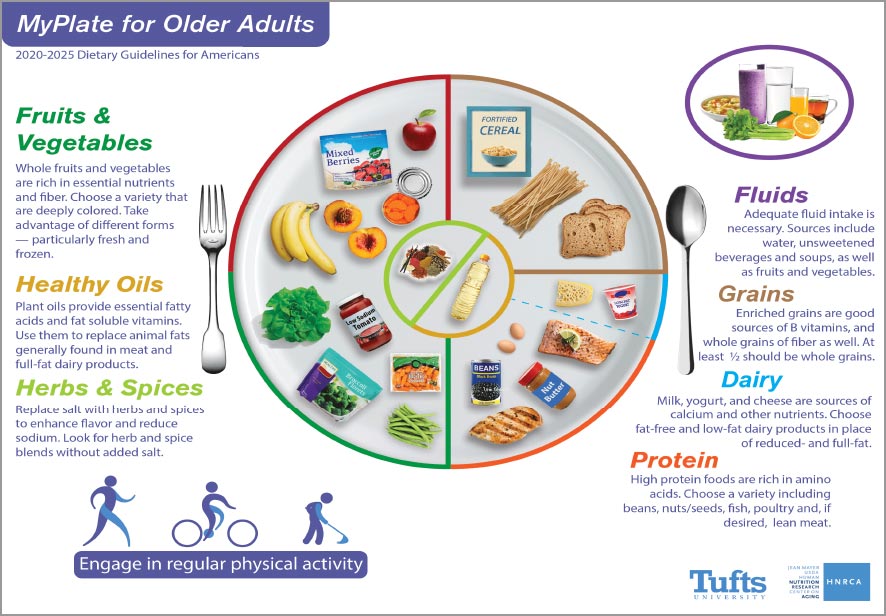by Cynthia Germain
Eating well is one of the most powerful ways to stay active, independent, and energized as we age. But knowing what “eating well” looks like can be unclear. We know that our bodies change, our metabolism slows, and the way we absorb nutrients can shift. How do we eat to give the body what it needs, support bone and muscle health, and boost overall well-being? Fortunately, there are simple visual tools that make healthy eating easy to understand and follow.
You may be familiar with MyPlate, the simple visual guide from the U.S. Department of Agriculture (USDA) that replaced the old food pyramid. MyPlate shows what a balanced meal looks like:
- Half your plate fruits and vegetables
- One-quarter whole grains
- One-quarter protein
- A serving of dairy (or fortified alternatives)
This is the gold standard for a healthy diet. But as we age, we can benefit from even more specific guidance.
Researchers at Tufts University created MyPlate for Older Adults, which adapts the standard plate to the unique needs of aging bodies. It emphasizes:
- Hydration: Water, tea, coffee, and other low‑sugar drinks are front and center, since older adults are more prone to dehydration.
- Nutrient‑dense foods: Bright fruits and vegetables, lean proteins, and whole grains that pack more nutrition per bite.
- Protein variety: Fish, beans, eggs, nuts, and lean meats to help maintain muscle strength.
- Flavor: Herbs and spices enhance taste without extra salt.
- Physical activity: Gentle reminders that movement supports nutrition for overall well‑being.

This model is an uncomplicated way to make a healthy plate of food for someone over 60.
Then there’s the fact that 1 in 3 older adults have Type 2 Diabetes. For older adults managing blood sugar and looking for another simple visual, the American Diabetes Association’s “Create Your Plate” method is easy to follow:
- Half the plate: Non‑starchy vegetables like broccoli, spinach, or peppers
- One‑quarter: Lean protein, such as chicken, fish, tofu, or beans
- One‑quarter: Healthy carbohydrates, like whole grains or starchy vegetables
- Optional side: Fruit or dairy, in portion‑controlled servings
This approach supports steady energy, blood sugar management and balanced nutrition.
No matter which visual guide resonates most with you, the goal is the same: variety, balance, and mindful portions. A few simple steps can make your meals “age‑smart”:
- Color your plate: Choose a rainbow of vegetables and fruits.
- Add protein to every meal: Keeps muscles strong and energy steady.
- Hydrate often: Drink water even if you don’t feel thirsty.
- Make small swaps: Choose whole grains over white flour products, herbs over salt, and fresh over fried when possible.
When meals are simple, colorful, and balanced, you give your body the fuel it needs to age with vitality, that zest for life that comes from strength, energy and wellness.

